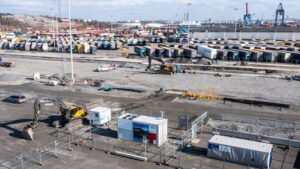In recent weeks, emission-free excavation work has been carried out in one of the Port of Gothenburg’s largest infrastructure projects ever, using a hydrogen generator with completely new technology piloted in the project.
The generator is a scalable and portable plug-and-play solution that can be easily moved and used on the go. It includes fuel cell modules, power electronics, cooling, auxiliary systems, and an intelligent control system. Hitachi Energy’s technology partner, PowerCell Group, provides the power modules and expertise in fuel cell integration.
Pilot tests at the new terminal area, Arendal 2 in the Port of Gothenburg mark the first field test of Hitachi Energy’s hydrogen generator.
The generator has been in operation for the last two weeks using green hydrogen from Linde Gas to generate electricity for a charging station on-site. In turn, the charging station supplies electricity to an electric excavator from Volvo, which is used in one of the port’s major infrastructure projects where 140,000 square meters of new terminal area is being created in the outer areas of the Port of Gothenburg.
Arendal 2 is the largest terminal development project in the Port of Gothenburg the 1970s. The terminal area rests on a foundation of blasted stone and contaminated dredged material reused as fill material. Stabilization and solidification of contaminated dredged material are new techniques developed during the project’s early stages in 2016.
“So it’s particularly exciting that we’ve had the opportunity to test the facility in this project, where collaboration, sustainability, and innovative solutions have truly characterized the work from day one,” says David Norén, project manager for Arendal 2 at the Gothenburg Port Authority.
Hydrogen – ideal in a port environment
The Port of Gothenburg aims to reduce port-related CO2e emissions by 70 percent, from Vinga out to sea, to the entire Gothenburg area on land. There is a strong focus on creating conditions for the transition of maritime and land traffic through fossil-free infrastructure and accessibility to a mix of alternative fuels.
Hydrogen has greenhouse gas reduction potential in all these areas, says Viktor Allgurén, innovation manager at the Gothenburg Port Authority:
“In a diverse and energy-intensive operation like a port, there are many areas of use. It can be used as fuel for trucks, trains, or handling equipment in terminals, for propulsion of ships, or to support the power grid when a ship is connected to shore power. So the use of hydrogen fits perfectly into the port context.”








